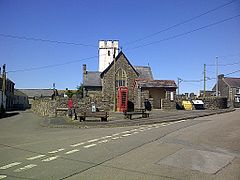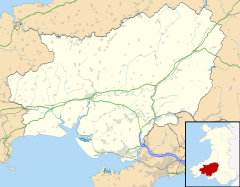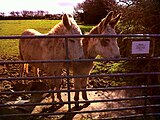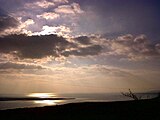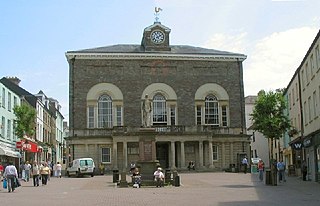
Carmarthenshire is a county in the south-west of Wales. The three largest towns are Llanelli, Carmarthen and Ammanford. Carmarthen is the county town and administrative centre. The county is known as the "Garden of Wales" and is also home to the National Botanic Garden of Wales.

Carmarthen is the county town of Carmarthenshire and a community in Wales, lying on the River Towy 8 miles (13 km) north of its estuary in Carmarthen Bay. The population was 14,185 in 2011, down from 15,854 in 2001, but gauged at 16,285 in 2019. It has a claim to be the oldest town in Wales – Old Carmarthen and New Carmarthen became one borough in 1546. It was the most populous borough in Wales in the 16th–18th centuries, described by William Camden as "chief citie of the country". Growth stagnated by the mid-19th century as new settlements developed in the South Wales Coalfield.

Ammanford is a town and community in Carmarthenshire, Wales, with a population of 5,411 at the 2011 census. It is a former coal mining town. The built-up area had a population of 7,945 with the wider urban area even bigger.

Llandeilo is a town and community in Carmarthenshire, Wales, situated at the crossing of the River Towy by the A483 on a 19th-century stone bridge. Its population was 1,795 at the 2011 Census. It is adjacent to the westernmost point of the Brecon Beacons National Park. The town is served by Llandeilo railway station on the Heart of Wales Line.

Nevern is both a parish and a community in Pembrokeshire, Wales. The community includes the settlements of Felindre Farchog, Monington, Moylgrove and Bayvil. The small village lies in the Nevern valley near the Preseli Hills of the Pembrokeshire Coast National Park 2 miles (3 km) east of Newport on the B4582 road.

The River Loughor is a river in Wales which marks the border between Carmarthenshire and Swansea. The river is sourced from an underground lake at the Black Mountain emerging at the surface from Llygad Llwchwr which translates from the Welsh as "eye of the Loughor". It flows past Ammanford and Hendy in Carmarthenshire and Pontarddulais in Swansea. The river divides Carmarthenshire from Swansea for much of its course and it separates Hendy from Pontarddulais at the point where the river becomes tidal. The Loughor meets the sea at its estuary near the town of Loughor where it separates the south coast of Carmarthenshire from the north coast of the Gower Peninsula. Among its tributaries is the River Amman and the River Morlais, with the former joining the Loughor near Pantyffynnon. The area of the catchment is some 262 square kilometres (101 sq mi).

Ferryside is a village in the community of St Ishmael, Carmarthenshire, Wales. It is 8.5 miles (13.7 km) south of Carmarthen near the mouth of the River Tywi. Originally a ferry crossing, then becoming a fishing village, it has developed as a holiday and retirement area. The village has its own lifeboat station and was the first village in the UK to switch from analogue to digital television. The 2011 census showed the village to have 846 residents.
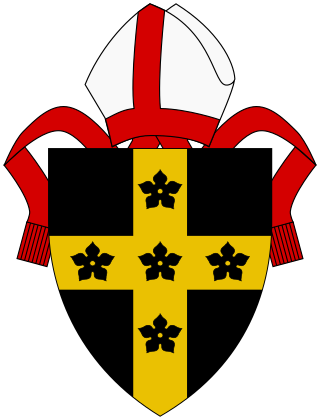
The Diocese of St Davids is a diocese of the Church in Wales, a church of the Anglican Communion. The diocese covers the historic extent of Ceredigion, Carmarthenshire and Pembrokeshire, together with a small part of western Glamorgan. The episcopal see is the Cathedral Church of St David in the City of St Davids, Pembrokeshire. The present cathedral, which was begun in 1181, stands on the site of a monastery founded in the 6th century by Saint David.
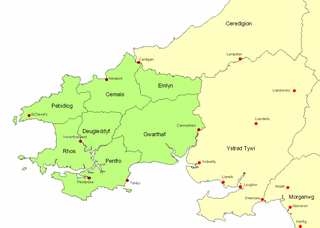
The Kingdom of Dyfed, one of several Welsh petty kingdoms that emerged in 5th-century sub-Roman Britain in southwest Wales, was based on the former territory of the Demetae. The medieval Irish narrative, The Expulsion of the Déisi, attributing the kingdom's founding to Eochaid, son of Artchorp, being forced across the Irish sea, in the 5th century; his descendants founding the line of the kings of Dyfed, down to "Tualodor mac Rígin". The Normans invaded Wales, and by 1138 incorporated Dyfed into a new shire called Pembrokeshire after the Norman castle built in the Cantref of Penfro and under the rule of the Marcher Earl of Pembroke.
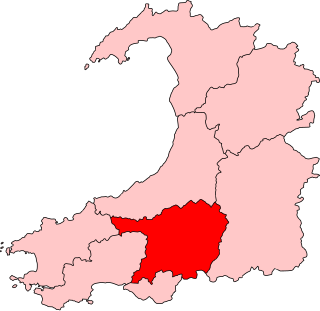
Carmarthen East and Dinefwr is a constituency of the Senedd. It elects one Member of the Senedd by the first past the post method of election. It is one of eight constituencies in the Mid and West Wales electoral region, which elects four additional members, in addition to eight constituency members, to produce a degree of proportional representation for the region as a whole.

St Ishmael is a hamlet and community in Carmarthenshire, Wales. The community population taken at the 2011 census was 1,370. It comprises the villages of Ferryside and Llansaint and the surrounding rural areas. The community is bordered by the communities of: Llandyfaelog; Kidwelly; Pembrey and Burry Port Town; and Llansteffan, all being in Carmarthenshire. It is named for the 6th-century Breton prince and Welsh saint Isfael.

Llanpumsaint is a village and community in Carmarthenshire, Wales. In the 2001 UK Census, Llanpumsaint community had a population of 595. It is not to be confused with Pumsaint, a small village some distance away on the River Cothi. The population increased in 2011 to 734, and thus the percentage of Welsh speakers declined.
Brechfa, situated between Llandeilo and Carmarthen in the county of Carmarthenshire, Wales, is a village that has existed since the 6th century at the top of the Cothi Valley. Brechfa village is set in countryside, as well as being located by the Brechfa Forest

Llansadwrn is a small village and community in Carmarthenshire, Wales.
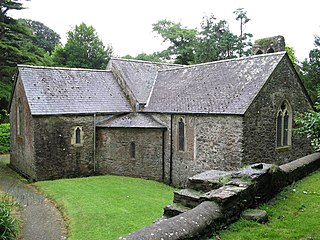
St Ishmaels or St Ishmael's is a village, parish and community close to the Milford Haven Waterway in Pembrokeshire, Wales. The community comprises most of the parish of St Ishmaels and had a population of 478 at the 2011 census. The ward includes the communities of Herbrandston, Dale and Marloes and St. Brides. The community was subsequently merged with other communities and only the ward remained with the name St Ishmael's. This covers the entire peninsula with a total population at the 2011 census of 1,405.

Llangynog is a village and community located in Carmarthenshire, Wales, the main settlement of which was once called ‘Ebenezer’village. It is bordered by the communities of: Newchurch and Merthyr; Carmarthen; Llangain; Llansteffan; Laugharne Township; and St Clears, all being in Carmarthenshire. The population at the 2011 census was 492.

Castell Moel is the remains of a 16th-century fortified manor house in the community of Llangain in Carmarthenshire, Wales, and also a medieval motte about 600 yards (550 m) to the south of the manor house. The remains are approximately 2.5 miles (4.0 km) south-west Carmarthen and 0.8 miles (1.3 km) north-east of the village of Llangain. Three miles to the north-west is Carmarthen Castle, and five miles to the south-west is Llansteffan Castle.
Isfael or Ismael, often anglicised as Ishmael, was a 6th-century medieval Welsh bishop of Rhos and saint. He was allegedly also a Breton prince of Armorica.
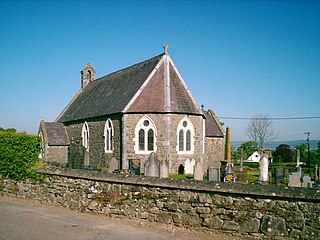
Cwmffrwd is a village in Carmarthenshire, Wales, located around two miles (3.2 km) south of Carmarthen.
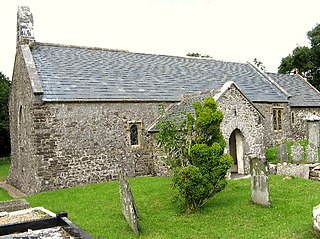
The Church of St Margaret Marloes is the Church in Wales parish church for the parish of Eglwyscummin, in southwestern Carmarthenshire, Wales. The present building dates from the 14th and 15th centuries with restoration work being undertaken in 1878 and again in 1900. The church has a round churchyard, an indication that this site has likely been used since prehistoric times. A tombstone dating back to the fifth century was found in the churchyard. It is believed that Saint Cynin founded the church as one of a series of missionary stations in the fifth century.
